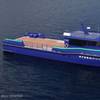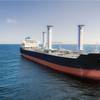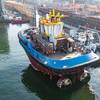New Innovative CNG-Electric Hybrid Ferry Texelstroom
The M/S Texelstroom is more energy efficient, cleaner and more sustainable than her predecessors.
CNG-electric hybrid ferry Texelstroom features some of the latest technological developments and innovation, such as a T-shaped beam which ensures a 14 percent car capacity improvement and a CNG/Diesel Hybrid propulsion which make the ship more cost-efficient and thus more environmentally friendly, says C-Job Naval Architects, who is responsible for the vessel’s complete initial, concept and basic design. Other innovations include solar panels, peak shaving batteries and heat recovery.
At 135 meters long and 28 meters wide, the new ship is 5 meters taller and wider than her predecessors, C-Job said, though the new Texelstroom is still able to dock in the same port as the Dokter Wagenmaker. The extra driving lanes placed next to upper car deck are situated over the bollards of the port because the docking harbor is relatively narrow. According to C-Job, this was quite a puzzle for the naval architects, but they, together with TESO, have achieved it by applying a T-shaped beam. The construction has resulted in an increase of capacity from 300 to 340 cars.
The ferry, classed by Lloyd’s Register, will sail between the Dutch islands of Texel and Den Helder and is ice class, with a strengthened hull in case of winter ice. Its design was supported by the European Union’s ‘I.Transfer’ Program, which aims to make ferry transport more freely accessible and sustainable, and encourage more people to travel by water.
To reduce future fuel consumption, TESO has chosen a combination of a main engine that runs on compressed natural gas (CNG – supplied by Pit Point clean fuels) which powers the electrical propulsion as well as the batteries (which will also be powered by sustainable energy) next to the diesel generators. Additionally, 462 solar panels can be found on the top deck. The combination of the CNG and the use of batteries is innovative and has never been done on this scale, C-Job said. The use of natural gas will result in a reduction of CO2 emission by 20 percent and soot emission will be reduced by 100 percent reduction, according to the designer.
The ferry has two completely independent engine rooms, each of which can provide enough power to be able to continue the normal service of the ferry at least up until wind force Bft 9. One engine room is fitted with two ABC diesel engines (2 x 2,000 kW), and the other with two ABC dual fuel engines (also 2 x 2,000 kW). On each ship end two Rolls Royce azimuth propellers will be installed, to achieve a speed of 10 knots (economic) and 15 knots (maximum).
The ferry’s interior and exterior designer Vripack implemented specific features of the Wadden area and the adjacent dune landscape in the design of the Texelstroom. As a result, the interior and exterior design is completely inspired on the island. Vripack carried out a market research and spoke with several islanders and visitors in order to achieve this goal. Their stories and the additional footage has resulted in three building blocks which were central to the vessel’s design.
These building blocks are leading for the interior design and have been the guideline for the choice in furniture and materials. But also the natural colors, such as the color of the sand dunes and the green of the beach grass, are present in the overall design. The interior of the salon has been decorated with a pine tree native to Texel and serves as a meeting point for travelers.
The salon deck has been equipped with various island-inspired seating areas, high tables with charging facilities for mobile hardware, a restaurant, an interactive play area for children and numerous screens which inform the passengers about the island and the surrounding area. Vripack said the routing aboard the ship allows the passengers to find their way easily and quickly, which also contributes to a positive experience on board.
Vripack has also implemented characteristic elements into Texelstroom’s exterior design. The sheer of the ship is based on the wing shape of the little tern, a bird native to the area. The large windows in the heart of the salon provide plenty of daylight and strengthen the ‘Wadden feeling’. The glass panels are supported by a grid of arches, for which the pine cone scales were a source of inspiration. The exterior was given the original colors ‘yellow and white’ which represent the identity of the ferry service.
Courtesy C-Job Naval Architects
Another picture of interiors Photos C-Job Naval Architects
Engine Room Photos C-Job Naval Architects
Interiors Photos C-Job Naval Architects














